Cloud-native development and Software-as-a-Service accelerate app delivery
Strategic differentiation often stems from custom applications. Cloud-native development is an IT operating model to design and manage applications as-a-service on any cloud—public, private, hybrid, or the edge. Software is everywhere, both in the products enterprises deliver to their customers and partners, and in the processes that create and support those products. Companies’ ability to win, serve, and retain customers depends on their ability to deliver new capabilities through software applications, rapidly and continuously.
Cloud-native is a common term today, but is it more than just a buzzword? Could it be the next phase of modern application development?
All signs point to yes.
As organizations seek to develop high-quality applications faster and more securely, developers and operations teams naturally look for ways to deliver these applications that run as-a-service anywhere with consistent and rapid application life-cycle management experience.
Cloud-native development survey
To gauge adoption of cloud-native development, Red Hat surveyed a group of IT professionals. The results detailed in this report are based on 817 qualified responses from Red Hat® customers. The survey was conducted from December 23, 2020 to January 9, 2021, and each interview lasted 15 minutes. Panelist criteria:
- Be employed full time or part time
- Work at a company with US$10 million+ in revenue
- Act as a decision influencer for application development and integration
Five key takeaways
1. Level of cloud-native adoption is directly proportional to software delivery performance
The survey revealed a direct relationship between the adoption level of cloud-native development practices and technologies and the performance of software delivery. 51% of adoption leaders exhibited a software delivery cycle of 1-4 weeks, whereas around 15% of those who are stalled in their adoption journey spend 7-12 months. Higher performance is, in turn, directly related to budget allocation. 73% of customers in the advanced stage of cloud-native development adoption expect the cloud-native development budget to increase in the next 12 months.

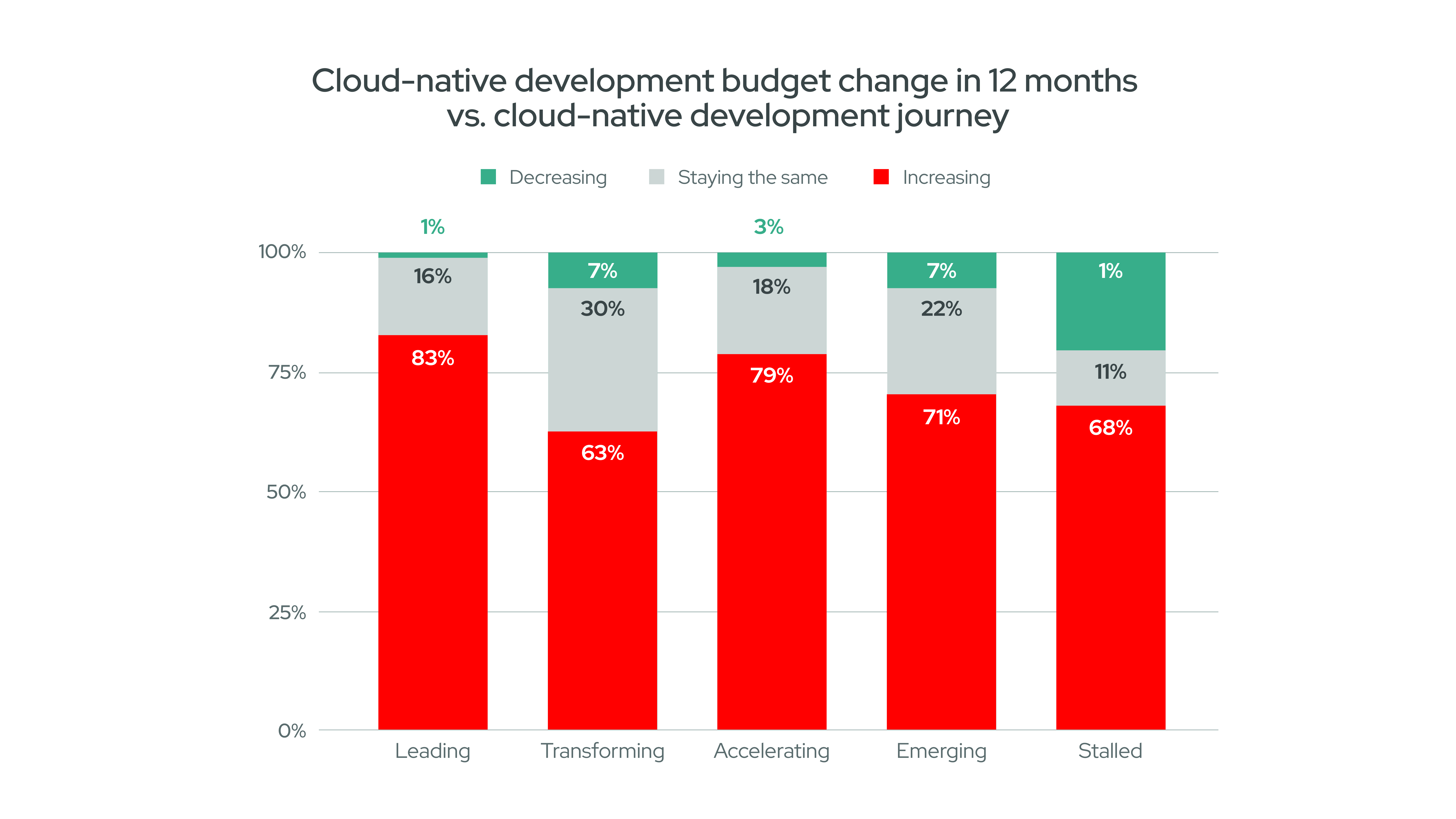
Red Hat perspective
At Red Hat, we believe improving software delivery with practices like continuous integration and delivery (CI/CD) is the key to digital innovation. IT teams must modernize their application infrastructure, architecture, and processes to deliver higher-quality applications with greater agility. Each of these is intertwined— improvements in one area demand improvements in another, so holistic improvement is critical.
Organizations that did not start out digital can overcome disruption from digital natives through strategic investments and commitments in agile software development and delivery capabilities using open, proven, and integrated Red Hat® platforms. Red Hat OpenShift® and our application services work together to help customers develop, deliver, and run dynamic, connected, and intelligent applications based on industry standards like containers and Kubernetes across any cloud. Teams can focus on building applications that move their business forward, leaving operations and infrastructure to the platform. While digital natives build their own tools and technologies from scratch, those that choose Red Hat will be operational immediately.
Red Hat Consulting and Red Hat Training and Certification teach and mentor your team on cloud-native development architecture and practices, helping you align your projects to business outcomes and business success.
2. Cloud-native development is a team effort
Over half of respondents report that adoption of DevOps, leadership support, and expertise in domain-driven design are the most important enablers of cloud-native development.
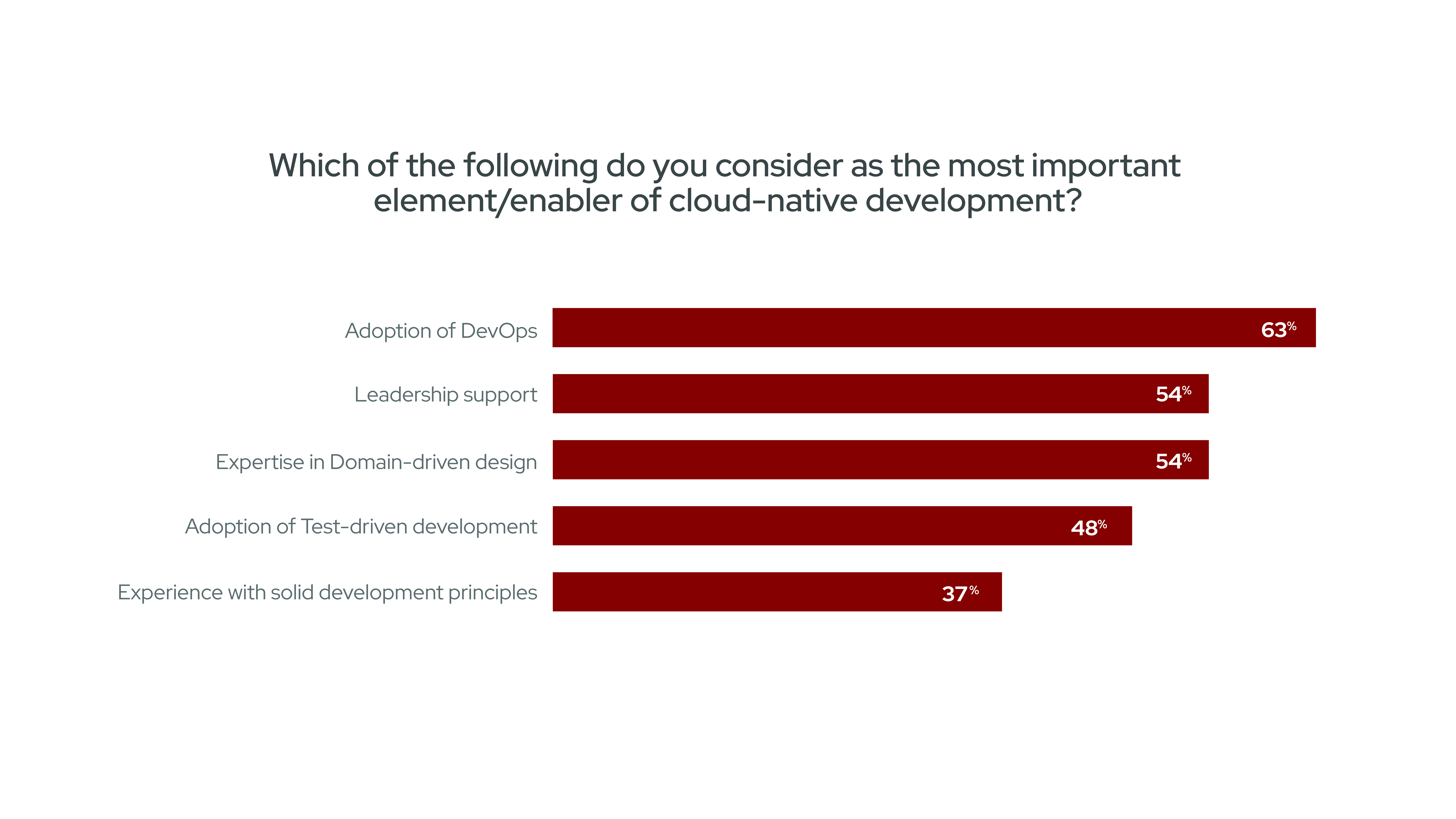
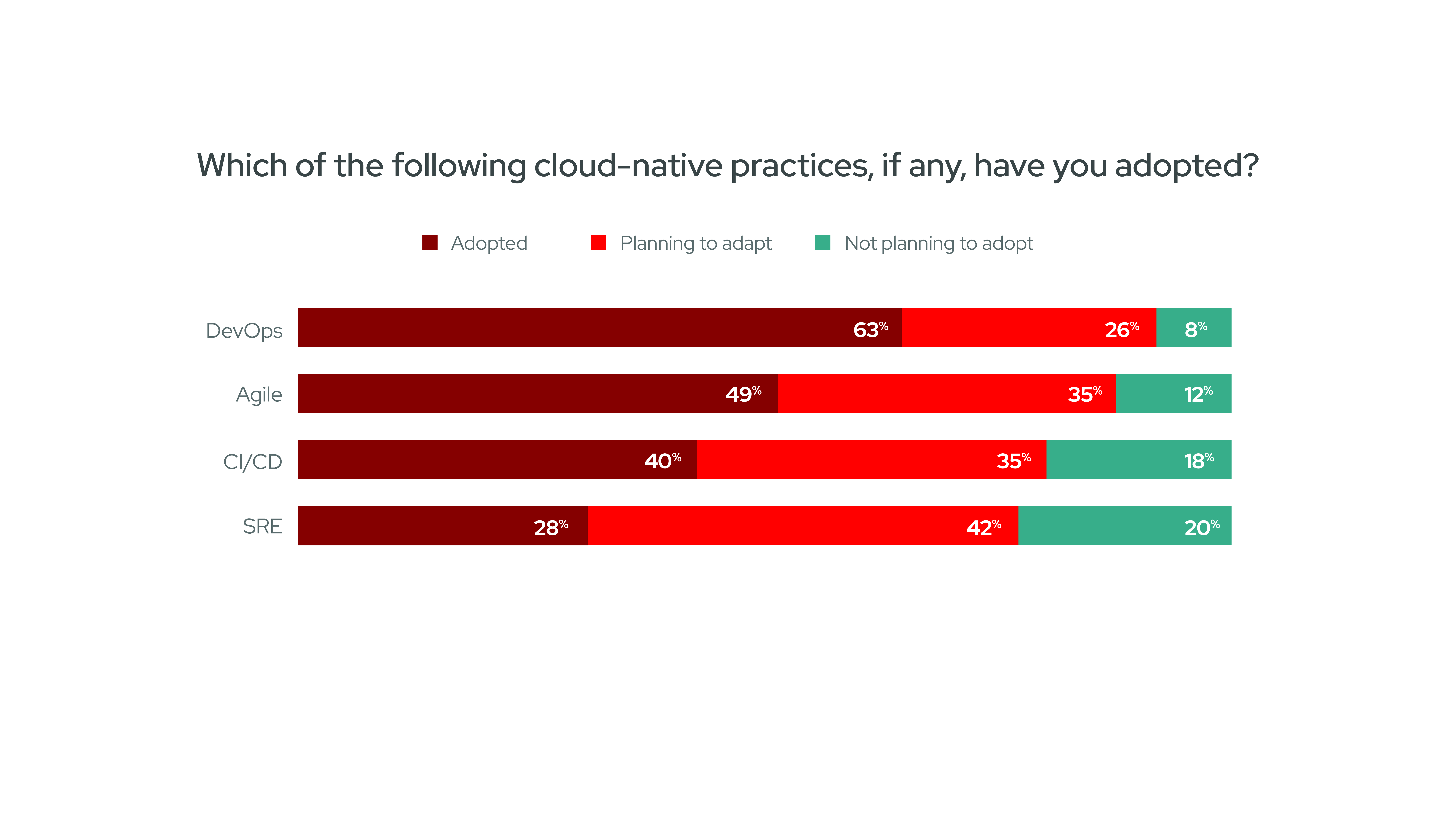
Red Hat perspective
The real value from cloud-native development goes far beyond the technologies closely associated with it. At its core, cloud-native development is as much about teams, people, and collaboration as it is about technology. That is, cloud-native is much more than just a programming model or a new way of writing code. It changes the entire software development life cycle from gathering requirements to continuous delivery of new features and code. Collaboration is key to building apps in an iterative, flexible way — stakeholders and makers all need to contribute to how the product is created, coded, tested, and deployed.
DevOps is really all about collaboration. It's about taking ownership of the solution you're building by bringing down barriers and removing bottlenecks and obstacles. This approach speeds up the value stream connecting the customer's perceived need to a product that’s delivered and deployed continuously.
Technology alone will never solve all your business problems. No matter how good the platform or software product is, unless your organization has learned to adopt the correct balance of people aspects, process changes, and technology adoption, the objectives will not be met.
Red Hat believes every company should improve its software delivery if it wants to become a digital innovator in its industry. To enable their enterprises to seize digital business opportunities, IT teams must modernize their application infrastructure along with architecture and processes. Teams must focus on all three because, now more than ever before, application architecture, platform, and delivery processes are intertwined. Improvements in one area demand improvements in another, and failing to improve holistically will not deliver optimal results.
It is clear that DevOps is maturing in adoption and site reliability engineering (SRE) is taking hold as 42% of respondents reported plans to adopt SRE practices. SRE has a much more prescriptive way of measuring and achieving reliability through engineering and operations work. It prescribes how to succeed in the various DevOps areas. DevOps and SRE are not two competing methods for software development and operations, but rather allies that work together to break down organizational barriers to deliver better software faster.
3. Improving collaboration among stakeholders is the key to success
In response to the question “Which of the following are key drivers for adopting cloud-native development practices and technologies,” a majority of respondents (55%) cited the need to improve alignment and collaboration between business and IT. This result indicates that successful cloud-native development is not about improving IT, but improving business outcomes that require greater collaboration between business and IT.

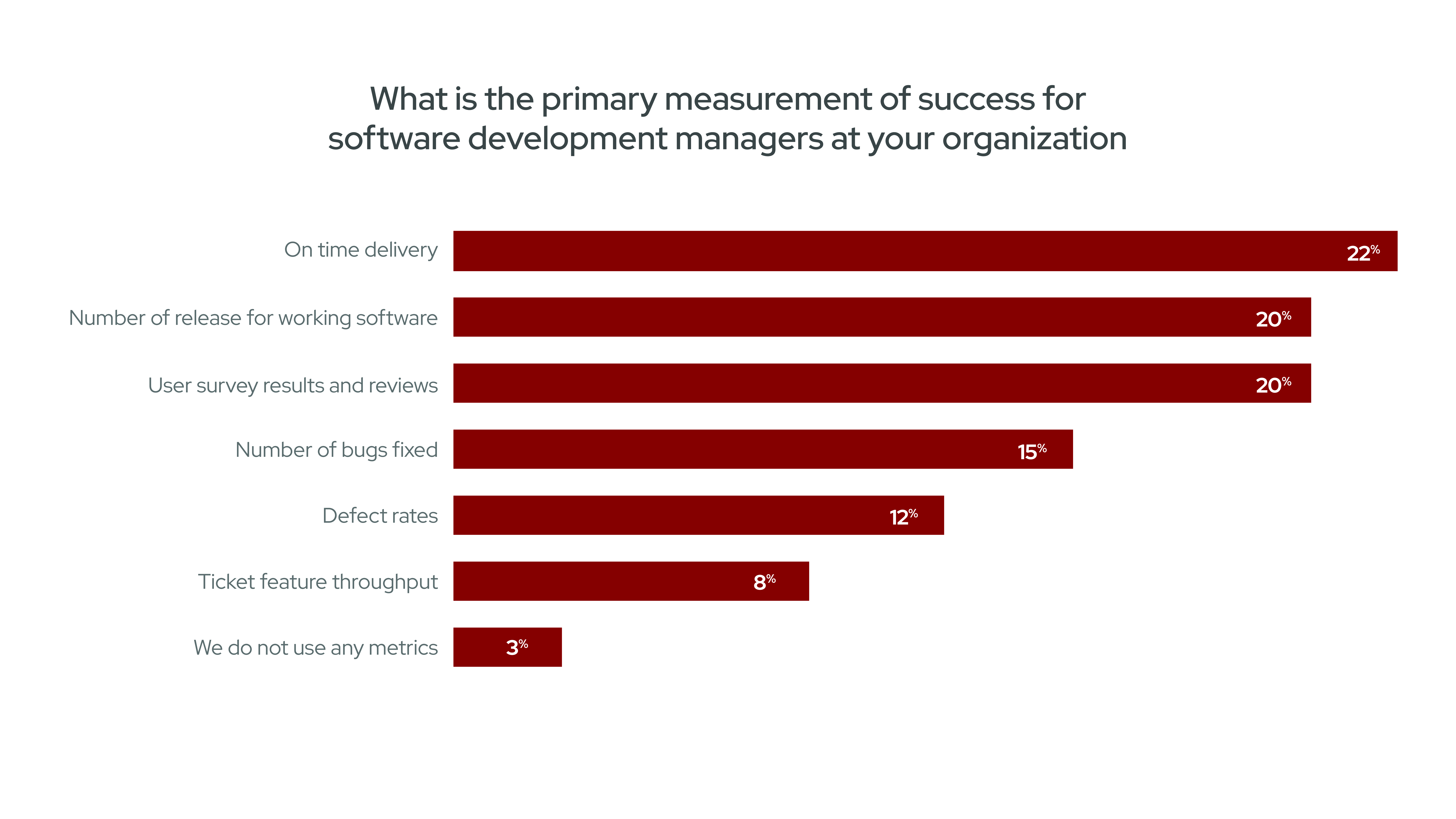
Red Hat perspective
Software has become the foundation for doing business, and it is no longer just a back-office function. It is critical for both the IT organization and the business it serves to recognize this significant shift in the use of software.
Customers expect to interact with businesses at any time from any place, which requires apps to be available as a service. Software has become customer-facing (in the truest sense of the term) for businesses. Whether it’s the company website, mobile app, or a social media presence, software applications are now the critical connector between businesses and their customers.
Success is no longer just about the output. It’s now also about the outcome. What is the customer experience during interactions with software applications provided by a business? Is the user experience, when interacting with that application, smooth and intuitive? And just as important, are employees having positive experiences and able to get their work done at the right quality and quantity using technology?
The conversation between the IT organization and the business it serves must shift from one of “outputs” to “outcomes.” Many IT organizations only report on the activities that they’ve accomplished, e.g., number of releases, on-time delivery, and not on the outcomes achieved by the business in its use of software applications, e.g., user reviews.
Why is this so important?
It moves the perception of IT from being an “order taker” within the business to a “value enabler.” It’s a far different perception when IT looks and acts like a drive-through restaurant than when IT looks and acts like it is a business enabler.
4. Delivering innovation is a balancing act between developing new applications and improving existing applications
When asked about the projects they plan to undertake over the next 6 to 18 months, survey respondents cited “apps that replace, modernize, or integrate legacy systems” as their top answer. Further breakdown shows that 37% plan to integrate existing applications to drive new capabilities, 32% plan to replace existing applications with Software-as-a-Service (SaaS)-based applications, and 29% plan to recreate a new application.
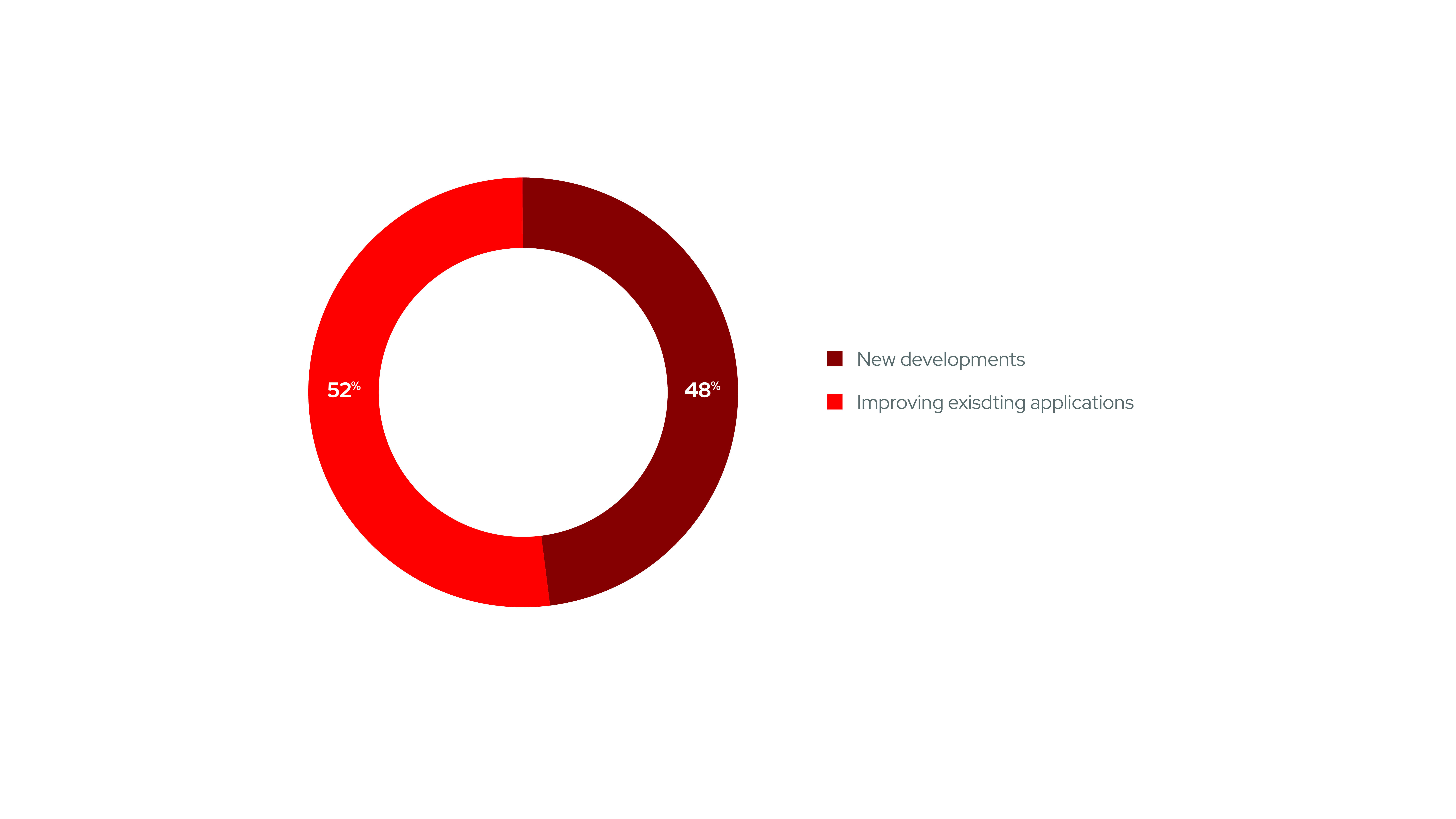

Furthermore, nearly 40% of respondents indicated that their preferred strategy is to create composite applications by buying foundational services as SaaS and focusing internal efforts on "customization" and "composition" for strategic functional and experience differentiation.
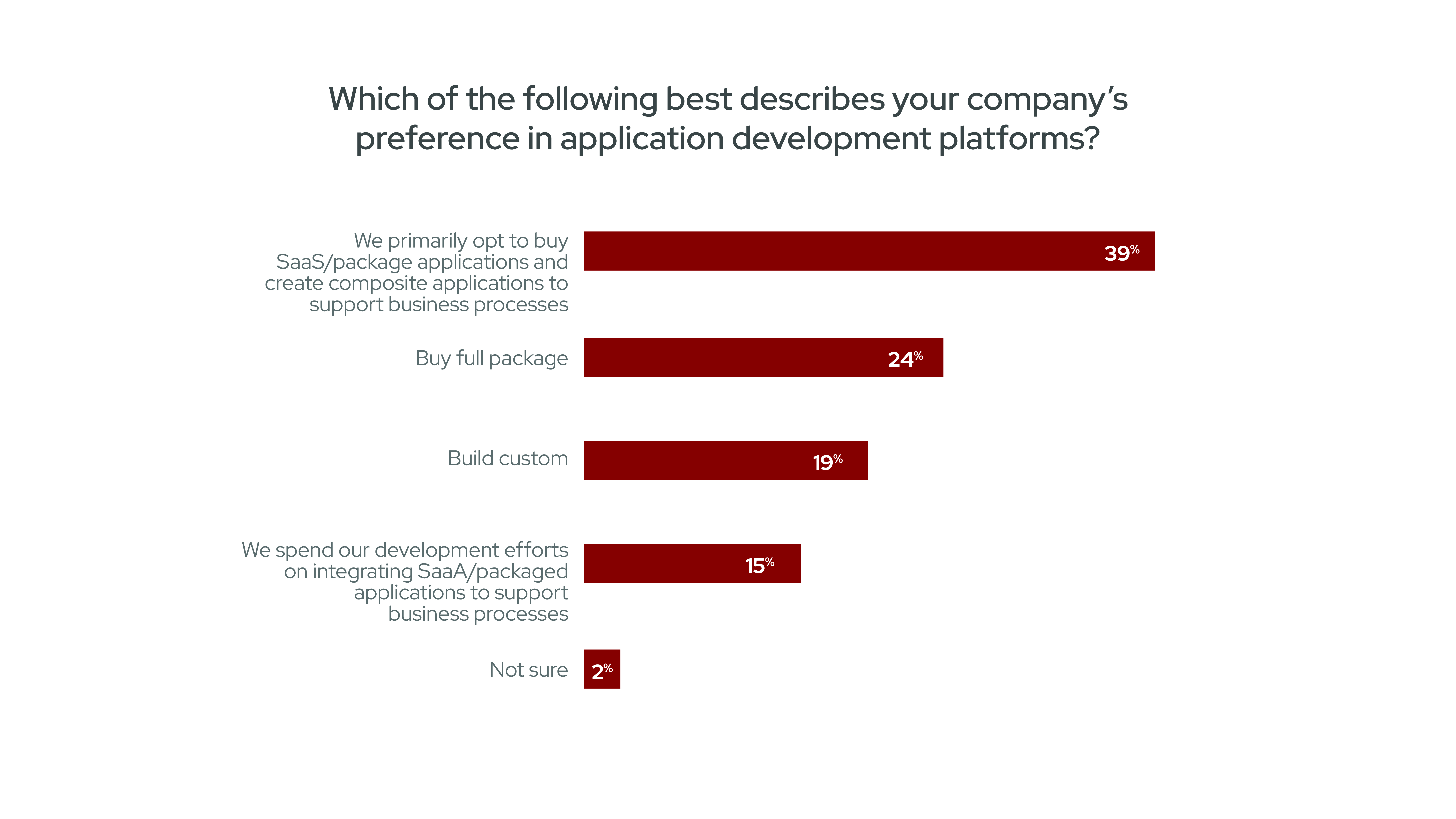
Red Hat perspective
The move toward cloud-native development reflects a new way of creating applications. It is no longer about building large applications from the ground up. Modern applications are composed of small, independent, and loosely coupled microservices. They are assembled by combining services from existing applications, much like the automotive industry uses parts from different automobiles to build cars.
Composable businesses are the enterprises that take advantage of composable architectures to build and adapt their digital solutions faster, both for internal and external users.
Composable architecture uses application programming interfaces (APIs) to enable all the systems and processes within the enterprise and its partners, allowing access to it by the developers and business users, and then dynamically combines those APIs into digital solutions to support ever-changing business needs. A key idea to make it more efficient is to divide large, complex systems into smaller autonomous components (in the true spirit of event-driven microservices architecture). This approach is called disaggregation, which is the opposite of aggregation.
These smaller components of enterprise architecture enable much more flexibility than the monolithic architectures of the past.
There are different ways to make these components available to the rest of the organization and to external partners. Usually this type of architectural integration is the combination of representational state transfer (REST) web services, SaaS APIs, microservices, and serverless functions.
Enterprises have hundreds or even thousands of applications, systems, and APIs.
Cloud-native development allows for flexibility, so enterprises can pursue multipronged development strategies that meet all of their modernization and innovation needs. With flexibility, tailoring application development to top organizational goals becomes easier. The trick is to choose the right application strategies and practices and map them to organizational goals.
We recommend that our customers consider the following three dimensions when setting their application development strategies. These considerations will help them achieve their objectives, whether the business aims to extend the reach of its business through customer-facing applications, use the Internet of Things (IoT), or other priorities.
- Design for change and scale. With dynamic application development, modular applications with reusable components allow for continuous delivery of new applications and features.
- Develop connected applications that run everywhere. They allow organizations to communicate with partners, customer ecosystems, and the IoT. Connected application development has event-driven architectures that adapt and make intelligent, data-based decisions in real time.
- Use artificial intelligence (AI)-driven automation, integrated analytics, and self-governance. With these tools, you’ll produce applications that automate routine tasks, improve business processes, and better serve customers. Intelligent applications can improve productivity, reduce legal and compliance risk, and improve customer interactions.
Red Hat provides a unified cloud-native portfolio that offers polyglot, multiarchitecture, and multidevelopment support to design and run applications as-a-service on any cloud—public, private, hybrid, and the edge. Red Hat provides consistent development and management experience to develop, modernize, and integrate data and applications using services-based and API-driven architecture, container orchestration, and agile DevOps process automation. This approach allows organizations to focus on application development strategies best suited for their unique needs and provides both in-person and online training courses to help them put these strategies into practice.
5. Organizations need help selecting the right tools
41% of respondents said that selecting the right technology to use for their cloud-native development needs was their biggest challenge. An equal number noted that security policies were a challenge.

Survey respondents who are trying to build their own opinionated application platforms list cost (46%), scalability (38%), and skills gaps (34%) as the top issues.
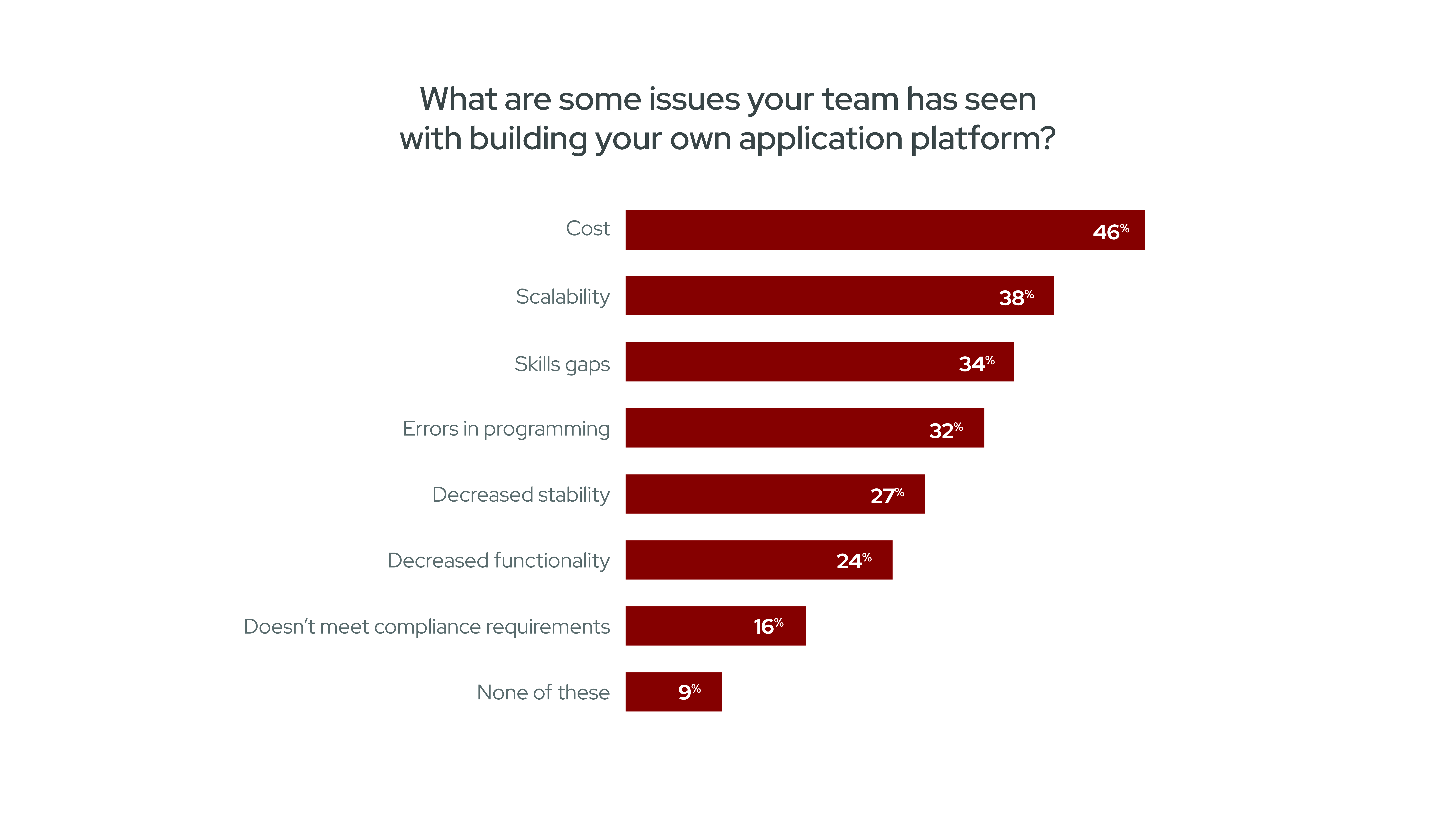
Red Hat perspective
A quick glance at the cloud-native landscape provides great insight to the rich ecosystem of cloud-native technologies. The options can be intimidating for even the most experienced software organization. It is no wonder that IT leaders find it difficult to choose the right tools for the job. They need prescriptive recommendations to help them select the appropriate technologies.
Red Hat helps organizations take the guesswork out of assembling their own cloud platforms. For the past several years, Red Hat has emphasized the interplay of IT’s four footprints, from physical servers and virtual machines to private and public clouds. A single environment is unlikely to scale and adapt to meet the needs of the modern enterprise—from competitive dynamics to evolving customer demands. Hybrid cloud, where workloads and resources span these deployment options, is now a critical component for digital transformation, as is consistency. CIOs need to know that their applications and services will respond consistently in a certain way, every time, everywhere.
But here’s what is new: These four footprints are immaterial to the end user. The hybrid cloud is becoming a default technology selection. Enterprises want the best answers to address their problems, regardless of what footprint it exists in or which vendor offers it. We’ve reached what we believe is an inflection point in enterprise IT, where the underlying foundations of the technology stack are commoditized. What enterprise users do care about, regardless of role, is that the technology stack meets their needs, is stable, has strong security, and can scale to address future needs.
Red Hat provides a common platform that offers a stable, consistent, and reliable fabric that stretches across the four IT footprints, regardless of the underlying hardware, service, or provider. This platform provides consistency and abstraction, allowing IT teams to focus on embracing innovation rather than trying to integrate legacy technologies with emerging cloud services.
Conclusion: Collaboration and security are crucial for future growth
Our survey confirmed that cloud-native development is not just a buzzword or passing fad, and our results revealed some noteworthy concerns and key drivers for adoption. In particular, organizations are focused on building better security into their application development processes. Organizations are also looking for ways to become more collaborative and determine the best technologies for their needs.
It is apparent that cloud-native development is quickly becoming the preferred method of developing and modernizing applications. Its continued success will depend on organizations’ abilities to encourage collaboration and build team structures that support the use of hybrid cloud platform automation tools like Kubernetes and microservices to boost innovation velocity.
Learn more
To learn more about Red Hat and cloud-native development, visit https://www.redhat.com/en/topics/cloud-native-apps, or contact us.
